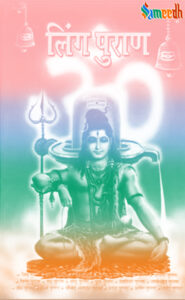The Ling Puran is one of the major eighteen Mahāpurāṇas, a genre of ancient Indian literature that focuses on mythological stories, cosmology, genealogies of gods, goddesses, and legends. The Ling Puran, as its name suggests, centers around the worship of Lord Shiv, particularly in the form of the Ling, which is a symbolic representation of the divine.

The Ling Puran provides explanations for the origin of the Shiv Ling, the iconic symbol of Lord Shiv. It narrates the cosmic story of how Lord Shiv, in the form of an infinite pillar of light (Jyotirling), manifested to demonstrate his transcendental nature.
The Ling Puran consists of eleven sections (khaṇḍas) and is primarily dedicated to the praise and description of Lord Shiv. It covers a wide range of topics, including creation myths, cosmology, philosophy, rituals, and the significance of different forms of worship associated with Lord Shiv. The exact origins and authorship of the Ling Puran remain uncertain, but it is typically considered to have been composed between the 5th and 16th centuries CE.
The text is believed to have been composed in Sanskrit and, like many ancient Hindu scriptures, has been transmitted through various manuscripts. It is considered an important source for understanding the Shaiva tradition and the worship of Lord Shiv. The Ling Puran is revered by devotees of Shiv and scholars interested in Hindu mythology and religious practices.
The Ling Puran contains various stories and legends related to Lord Shivand his worship. Here are a few popular stories from the Ling Puran:
- Demon King Ravan’s Devotion: The Ling Puran tells the story of Ravan, the demon king of Lanka (Sri Lanka). Ravan was a great devotee of Lord Shiv and performed intense penance to obtain the blessings of the god. Impressed by Ravan’s devotion, Shiv granted him a powerful Ling, known as the Rameshwaram Ling. However, there was a condition that Ravan should not place the Ling on the ground until he reached Lanka. As fate would have it, Ravan had to hand over the Linga to Lord Ganesh, who cleverly placed it on the ground, and it became the famous Rameshwaram Ling.
- The Story of Lord Kartikey: The Ling Puran narrates the birth and exploits of Kartikey, the son of Shiv and Parvati. Kartikey is known as the god of war and victory and is often associated with the Tamil festival of Thaipusam.
- Daksha Yagna and Shiv’s Wrath: The Puran describes the incident of Daksha’s Yagna (sacrificial ritual), where Daksha, the father of Shiva’s consort Sati, insulted Lord Shiv. Sati, unable to bear the insult, immolated herself. This event led to Shiv’s intense grief and anger, resulting in the destruction of Daksha’s Yagna and the subsequent beheading of Daksha. The Ling Puran provides details of this significant episode.
- Story of Lingodbhava: The Ling Puran contains the story of Lingodbhava, which explains the superiority of Lord Shiv over Brahma and Vishnu. It narrates how Shiv manifested as a fiery pillar of light, challenging Brahma and Vishnu to find his beginning and end. This event symbolizes the infinite and formless nature of Lord Shiv.
These stories and narratives from the Ling Puran contribute to the rich tapestry of Hindu mythology and play a significant role in shaping the beliefs and practices of Shiv devotees.
